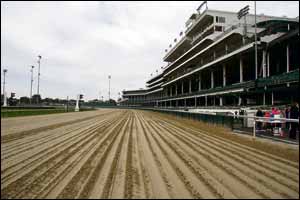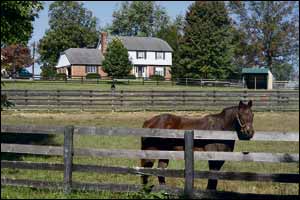 | ||
| Horses and Bourbon are part of Kentucky’s fabric | ||
The state accounts for 95 per cent of America’s Bourbon and Jews were at the forefront of the industry. In 1867, Isaac Wolfe Bernheim arrived in America from Germany and went on to build one of the biggest whiskey brands in the world. In 1868 two distillers from Paducah, Kentucky employed him as a bookkeeper. When his brother Bernard joined him in America, they opened their own distillery in 1872. They used the anglicised brand name IW Harper and soon moved their operation from Paducah to Louisville which had a rich tradition of Jewish distillers. Although Jews comprised only three per cent of Louisville’s population, they accounted for a quarter of the whiskey trade. Even today the tradition appears to be continuing. At Bottle & Bond in Bardstown I’m introduced to David Mandell, the 44-year-old co-founder and CEO of Bardstown Bourbon Company which opened last year. A Philadelphia attorney, he joined forces with fellow Jew, Los Angeles-born Dan Linde, who spent six years in London with an Israeli book publishing company and professes to be a Tottenham Hotspur fan. David says that the big Bourbon growth market in America is among young drinkers. Not far from Bottle and Bond is the Makers Mark distillery, founded by Bill Samuels, of Scottish-Irish descent. Spelling whisky without an ‘e’ is a nod to his Scottish heritage. And I learn on a tour that it was Bill’s wife Marjie who dreamt up the name, which she took from her collection of English pewter and the way craftsmen made a mark on their best pieces — the mark of the maker. It was her idea, too, to dip the bottle necks in molten red wax which still gives the whisky its distinctive appearance. Maker’s Mark is unusual in that no rye is used as part of the mash. Instead, the ingredients are red winter wheat (16pc), along with corn (70pc) and malted barley (14pc). Apparently as they experimented with Maker's Mark, Samuels developed seven different recipe mixes for the new bourbon. He had insufficient time to distill and age each one for tasting and instead baked a loaf of bread from each recipe. The one with no rye was judged the best tasting. Bardstown is home to five more well-known distilleries I also couldn’t miss visiting My Old Kentucky Home, one of America’s most iconic 19th-century properties. Named after composer Stephen Foster’s abolitionist inspired ballad, My Old Kentucky Home, Good-Night!, the Federal-style mansion commissioned by John Rowan Sr. was completed in 1818 and was the centrepiece of a 1,300-acre plantation. The first thing to remember about Louisville is to pronounce it correctly — Lourville. And then, that the city is only one of two in Kentucky designated ‘first-class’, all to do with its mayor-alderman form of government and its size.
The colourful Victorian homes were designed to mirror mansions in London. Aptly, America’s first pedestrian precincts in Louisville were named Belgravia and St James and today these elegant streets are still lined with the flickering gas lamps of the Victorian era. But that is to digress from the Bourbon industry and it is not all about actual distilling. A visit to Brown Forman Cooperage reveals that it is the only spirits company in the world to make its own barrels created from American white oak. Those hand-crafted barrels are used to age, among others, whiskeys for Jack Daniels, Woodford Reserve, Old Forester, Early Times, Canadian Mist, El Jimador and Herradura. Brown-Forman — a veritable galaxy of some of the most famous brands. Brown Forman produces a staggering 300,000 barrels annually, each cooper hand-crafting 250 a day. They cost $10,000 each and hold 250 bottles of Bourbon. “A barrel is more than a container for whiskey — it’s an ingredient,” I am informed. “You can coax colours, flavours and aromas from the barrel. One hundred per cent of the colour is from the barrel and 50 per cent of the flavour.” Bourbon, by law, must be aged in a brand new, charred white oak barrel to be called straight bourbon whiskey. And it is the charring that imparts the distinctive caramelised flavour. Interestingly, Bourbon County, in Kentucky originally did not produce Bourbon. Barrels of whiskey used to be sent down river from the local port on the Ohio and the journey took two months, during which time the contents had acquired a unique colour. It was made mostly from corn (maize) and had a distinctive flavour. South Louisville boasts Churchill Downs, the thoroughbred racetrack famed for the annual Kentucky Derby. Stepping on the specially prepared track, I was quickly shooed off but not before imagining the thunder of hooves that the May event brings. It is huge business with the winning horse attracting around $2 million in prize money. In the grounds are stables which are home to specially bred horses, only 20 of which get to race each year. Visitors can see them going through their paces each day. They have to be three years old to enter the race and it costs $50,000. I get a taste of the reality via a dramatic film screened around four sides of a room and learn much of the race’s glorious history at the on-site museum. Churchill Downs was officially opened in 1875 and the Kentucky Derby was based on the Epsom Derby after Col Meriwether Lewis Clark Jr, grandson of William Clark of the Lewis and Clark expedition, had visited England and witnessed the historic race there. Sheikh Mohammed, the largest thoroughbred racing horse owner in the world, owns the famed Godolfin Stables in Lexington which has produced three Derby winners. He hasn’t actually been seen there for some years. It gives some idea of the scope of the stables that one retired horse, Medaglia d’Oro, commands a $200,000 stud fee and can mate with 130 mares in a 10-week period. It should be noted that the fee is only payable if the mare produces a live foal. Perhaps the most poignant place in Kentucky is Old Friends Farm for Retired Thoroughbreds in Georgetown. There, former journalist Michael Blowen takes in retired racehorses which live out their final days with love and in luxury. Today, 100 roam the fields and stars of stage and screen who Blowen once interviewed have visited or, in Jack Nicolson’s case, become benefactors. One horse lived to 32 years-old. And when they die, their heads, hooves and hears are buried in the on-site cemetery. Blowen quipped: “Considering the members of my family, it’s worse losing a horse.” Visitors to Old Friends are starstruck when they realise they are coming face-to-face with some of the most famous racehorses. “People can’t believe they are meeting their horse heroes,” he said. Kentucky Derby and Preakness winners Silver Charm and War Emblem are among residents, as is Burt Bacharach’s horse Afternoon Deelites. Visitors are welcome and pay just $10 to meet their heroes.
If you have a story or an issue you want us to cover, let us know - in complete confidence - by contacting newsdesk@jewishtelegraph.com, 0161-741 2631 or via Facebook / Twitter

|
 CHURCHILL Downs, scene of the Kentucky Derby and (below) a horse enjoys his retirement at Old Friends Farm for Retired Thoroughbreds
CHURCHILL Downs, scene of the Kentucky Derby and (below) a horse enjoys his retirement at Old Friends Farm for Retired Thoroughbreds
